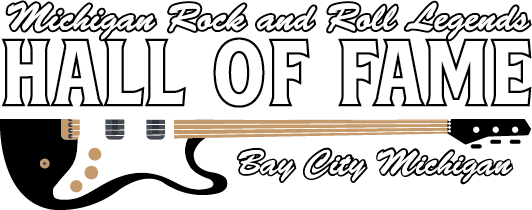"Dear Sir or Madam will you read my book, it took me years to write will you take a look" (Lennon/McCartney)
Saginaw teenagers Deb Harden and Jo Hintze didn't realize they would become female pioneers when they got a dream job writing a weekly column for the Saginaw News during the 1960's. Learning on the fly, their entertaining and informative columns provided an invaluable record of the vibrant Saginaw music scene and of the national and regional rock and roll artists who appeared there from 1965 to 1968.
In the July 7, 1967, edition of Time magazine, one of the articles described the emerging code of the hippie culture of San Francisco. First in line was “Do your own thing”; to do what you want to do without worrying about what other people think or want, and turn others on to beauty, love, honesty, and fun.
1969 was the year a lateral thought process called “Thinking outside the box” was introduced to corporate America in the person of John Adair. His message was to look further and not just try to think of obvious things, to try and think beyond that. In other words, Adair’s phrase referred to thinking differently, unconventionally, and from a new perspective.
Although coming from the polar opposite ends of the social and economic stratums of the United States in the 1960s, both of these catch-phrases describe to a great extent the kind of imaginative thinking exhibited in 1965 by a couple of energetic and talented young ladies named Deb Harden and Jo Hintze. The pair could often be seen in Saginaw, Michigan, bopping around town in their matching John Lennon-inspired Beatle caps, grooving to the latest British Invasion hits as well as the sounds of emerging area bands like ? And the Mysterians and The Bossmen. 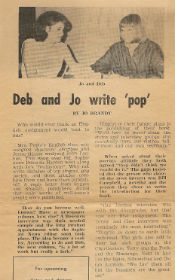 Jo (L) and Deb (R) at St. Andrew's High
Jo (L) and Deb (R) at St. Andrew's High
During the summer break between their freshman and sophomore years at St. Andrew’s High School, the two close friends came up with a creative plan to obtain a job unlike anything any Michigan teen had previously thought of - to become freelance pop writers and columnists for The Saginaw News!
They attained this lofty objective by not only daring to be different from other girls their age, but also combining this with dedication, hard work, and assertiveness seemingly beyond their years. For three years, Deb and Jo produced a highly informative and entertaining column that documented the national and local Pop/Rock artists who appeared in Saginaw, as well as the history of the two most important teen gathering places in the area during the 1960s, Daniel’s Den and the Y' A Go-Go. And they did all this well-before either “do your own thing” or “think outside the box” had become part of the popular vocabulary.
Deb Harden and Jo Hintze first became best friends in the second grade at St. Helen’s Grade School in Saginaw. Both joined the Brownies troop at the school and Mrs. Harden was the group leader. Their homes were close to the school and they clicked immediately as soon as they started to spend time together. Jo remembers that she “liked that Deb was fun and adventurous” and that “we had a good time together, and we were always cooking things up, even at seven years of age.”
The Beatles invaded the U.S. during Deb and Jo’s eighth grade year at St. Helen’s. Both became big Beatles fans, and they watched their early performances in 1964 on The Ed Sullivan Show seated directly in front of the black and while television at Deb’s house. Typical of fans of the ‘Fab Four’ all over the world, each had her favorite; Deb’s was George Harrison and Jo’s was John Lennon.
Since St. Helen’s was only a grade school, both girls enrolled at St. Andrew’s High School the following year. Although most of their teachers were nuns, Deb and Jo had a lay teacher named Mrs. Papia for their freshman English class. Forty-five years later, Jo (Hintze) Monday described her as being “with it, gorgeous, and nice.” Mrs. Papia was also wise enough to know that a good way to get her students interested in writing was to give them opportunities to write about what they love. 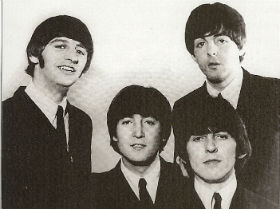 The Beatles 1965
The Beatles 1965
One of the assignments in Mrs. Papia’s class was to write character sketches, and Jo analyzed John Lennon. Her paper was a big hit with everyone in the class. Deb then suggested that they work together on a project to write sketches of top singers, pop poetry, and short articles, and then combine them into a book and have it published. They were inspired by the publication of the popular new book, John Lennon: In His Own Write, a collection of his writings and stories. Deb and Jo began work on their project after school, and even managed to convince an aspiring novelist named Bill Campbell to agree to write an introduction for them.
Despite the fact that even their parents didn’t think they would be able to pull it off, Deb and Jo completed their book by the end of the school year and sent it to Simon and Schuster in New York City. On July 9, 1965 they received a letter from the publishers thanking the girls for sending the manuscript but stating; “Unfortunately we do not publish volumes of original poetry and/or short stories. As you may know, they are difficult to market unless the authors are well-known to the general public through wide acceptance of their work through periodicals.”
How do you go about becoming well-known to the public through writing in periodicals when you’re just 15-years-old? While pondering their dilemma, both Deb and Jo needed to find a summer job. For most girls of that age in 1965, employment opportunity was pretty narrow; you could get a job working at one of the various soda shops or you could work in retail as a salesgirl. Both offered long hours and low pay.
But Deb and Jo were already thinking outside the box. They didn’t want to set limits on themselves and settle for the typical jobs offered to girls; they were interested in doing their thing, which at this time was being part of the music that they loved. So they hatched another creative scheme that, if successful, would in effect kill two birds with one stone. Their bold plan was to interview Saginaw’s most popular band, The Bossmen, write an article about them, and then present it to the Saginaw News. The hope was that the paper would then hire them to write a music-related column every week. 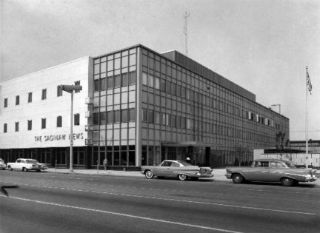 The Saginaw News
The Saginaw News
The Bossmen had released a couple of singles that got considerable airplay on WKNX-AM and were popular enough in the area to be considered almost as local equivalents to the Beatles. Deb and Jo had got to know the band from seeing them play in Saginaw and loved their records. They told Dick Wagner, the main singer and songwriter for the Bossmen, about their idea for a column and their plan to present it to the Saginaw News. Wagner, who was very adept at promoting his band, saw the potential and agreed to bring the group over to Jo’s house for the interview.
The girls wrote up their interview in the form of a news article in Jo’s backyard on a warm July afternoon. They then took the bus downtown and went directly to the office of Glen Boissonneault, the editor of the Saginaw News, and made an appointment to see him.
Looking at the rundown condition of downtown Saginaw today, it’s difficult to imagine what it was like over 45 years ago. In 1965, however, there were no malls to speak of and Saginaw was a shopping mecca for people from miles around. The girls spent a lot of time there while they were still in high school, and Deb and Jo would ride the bus downtown as often as they could.
Saginaw was bustling with eating establishments, a wide variety of large and small shops of every kind, and clothing stores galore. Although the prices were out of their range, the girls loved to peruse the latest styles at the trendy Village Store on S. Jefferson and upscale Jacobson’s Department Store on Federal. Each trip also meant a stop a Howard’s Music Center on Washington to check out the latest 45s. The two of them even adopted the current hit “Downtown”, by Petula Clark, as their personal theme song.
When the girls eventually met with Mr. Boissonneault, Deb and Jo presented their article on The Bossmen, and told him of their desire to write a column every week about the latest Rock and Roll happenings in Saginaw, especially those at Daniel’s Den on State Street, and at the dances sponsored by WKNX-AM deejays at the YMCA on Fordney.
.jpg) Daniel's Den
Daniel's Den
Boisnneault had to have been impressed by what these two cute and determined high school girls had already written, and it was pretty clear to him at this first meeting that they possessed the ‘right stuff’ to be successful reporters. Although the editor was intrigued by Deb and Jo’s idea, he didn’t become the chief journalist of the paper by making rash decisions. He would give their proposal more thought, and told them he would get back to them shortly with his decision.
What a thrill it was when, less than a week later, the editor called Deb and Jo to meet him in his office. He agreed to hire them to write a weekly column that would run in Showtime, an entertainment magazine and TV guide included in the Saginaw News every Saturday. It was further agreed that the girls would write each column in longhand and then take it to Boissonnault’s secretary by the Saturday edition deadline, and she would type it and check for spelling errors.
Deb and Jo were paid $20 for each column, which they would split 50/50. $10 per week was considered very good money for a 15-year old sophomore in high school in those days. Remembering back, Deb (Harden) Sheldon jokes that “the $10 kept us in bubblegum and cigarettes”; but best of all, their new jobs allowed them to write about popular music, the thing that was most important to them. 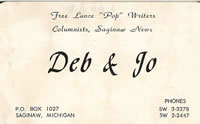 Their business card
Their business card
They were in business. The first thing the girls did was to rent a post office box at the downtown Saginaw branch. They next went to a local printer where they had “Deb & Jo” business cards printed indicating that they were “Free Lance Pop Writers” and columnists for the Saginaw News.
They also met with Frank Patrick, one of the owners of Daniel’s Den. The teen club had a rule that you had to be either 16-years-old or in the 10th grade in order to gain admittance. Once Patrick learned that the girls would be writing weekly columns in the newspaper that would undoubtedly help attendance at the Den, he bent the rules for Deb and Jo and also allowed them in for free. The Den had a very strict policy of not issuing passes out of the club, but since the girls would have to sometimes travel to the Y’ A-Go-Go for interviews on the same night, he waved that rule as well. Jo laughingly stated in one of our phone conversations that “Frank Patrick would have let the devil through the door if he thought it would get publicity for his club."
Their newspaper debut covered the first Saginaw appearance of The Shangri-Las in August, 1965, at Daniel’s Den. The teenaged girl group from Queens, New York, had become sensations the previous summer with their atmospheric Top Ten single, “Remember (Walking In The Sand)” and then followed it up with their melodramatic and controversial # 1 hit, “Leader Of The Pack”. The Shangri-Las were composed of two sets of sisters (one identical twins), and they wore tight black elasticized slacks and vests set off by white go-go boots. They not only looked and sounded different from the other skirt-wearing girl groups on the scene, but they also projected a “bad girl” image that wasn’t much of a stretch considering their years growing up in a tough neighborhood in New York City. 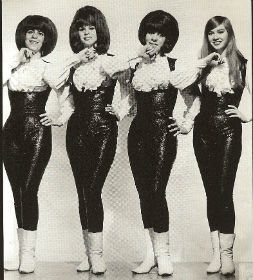 The Shangri-Las
The Shangri-Las
On their first night as journalists at Daniel’s Den, Deb and Jo were treated like minor celebrities. They were escorted by a Den staff member to the back stage area behind the large stage curtains where there were a few chairs set out to make it into a makeshift interview area.
The girls have stated on several occasions that this first interview was their toughest. It wasn’t because the Shangri-Las were uncooperative. They were national recording stars, however, and Deb and Jo were understandably nervous. It was their first job assignment, and they only had a short time with the group to complete their interview and then write it up and get it ready for publication. They didn’t own a tape recorder, so they both took notes. Since neither Deb nor Jo knew shorthand, everything had to be written out and they used their own method of abbreviation to save time. But when it came to quotes from the artists, the girls made it their policy with this first interview to be very accurate; and that meant writing things down word for word.
The Shangri-Las were all teens themselves, and probably recognized that Deb and Jo were also trying to be successful in a music field dominated by males. The girls became friends with the Shangri-Las at subsequent performances at Daniel’s Den and were even invited to visit them in New York. That never came to pass, but Jo still has a Christmas card sent to her by the group and their manager.
The next day, the girls got together in Jo’s backyard and began working on their very first column. Just like the nearly 140 to follow, Deb and Jo took hours to painstakingly put it together. It appeared in the Saginaw News on August 14, 1965, with the headline, “Saginaw Teens Go-Go For 4 Queens Queens”. A staff writer was responsible for the awkward title, but the rest of the column was all Deb and Jo.
Reading through it over 45 years later, it’s hard not to be impressed with their writing. Their review included a brief history of the Shangri-Las, the names of each member and their interests, highlights from their show including stage quotes from lead singer Mary Weiss, information about their touring schedule and the names of groups they’ve appeared with, and fashion details about their stage costumes. Deb and Jo’s article was aimed at the teenaged fans of the Shangri-Las, but it doesn’t sound juvenile in any way. It reads like a professionally reviewed concert common to any large newspaper. 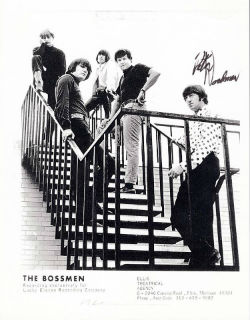 The Bossmen
The Bossmen
During their first year as journalists ‘Beatlemania’ was still going strong and everything English was cool. The girls employed a good deal of British slang terms in their early columns in an effort to keep them “switched on” and hip for teen readers. In this light, love is spelled “luv”, the guys in the bands were referred to as “blokes”, their friends were “mates”, and the fans were “ravers”.
Jo revealed to me recently that one the sources for these terms was a brochure called the Official British Dictionary – Latest English Teen Terms that was printed and distributed by the WKNX-AM 1210 Music Men, Bob Dyer and Dick Fabian. The pair sponsored the dances at the gymnasium in the YMCA in Saginaw on the weekends, transforming it into the Y’ A-Go-Go and stiff competition for Daniel’s Den.
Their second column on August 21st was the story they had already written on The Bossmen, but had been pushed back a week because of the Shangri-Las show. It would be the first of many features devoted to both The Bossmen and Dick Wagner’s next band, The Frost.
Deb and Jo’s next big interview took place just before the start of the new school year when Sonny and Cher came to the Den for three sold-out shows on Monday, August 23rd. Sonny and Cher were the hottest act in music at that time with four singles in the Top 20 as a duo, including the # 1 smash, “I Got You Babe”. Cher’s solo recording of Bob Dylan’s “All I Really Want To Do” was also a chart hit. Because of the crush of fans and tightened security, Deb and Jo interviewed Sonny and Cher in the basement of the Den. 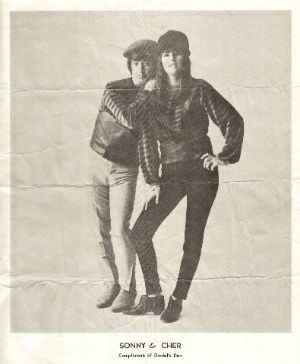 Complimentary photo of Sonny & Cher from Daniel's Den
Complimentary photo of Sonny & Cher from Daniel's Den
The girls rated it as one of their most interesting interviews. They were impressed with how down-to-earth both Sonny and Cher were, and Deb and Jo described them in their column as “the Romeo and Juliet of the 20th century pop world”. They also mentioned the warmth and friendliness the duo reflected on everyone around them. (As friendly as Sonny was to Deb and Jo, I did notice that he gave his age to the girls as 24 in the interview. Sonny Bono was born in Detroit on February 16, 1935. That would mean that he was really was 30 years-old at the time of the Daniel’s Den shows, “ancient” by 60’s teen standards.)
Because of their column, the girls were recognized in an article in the St. Andrew’s school newspaper after classes began in the fall. The Amplifier story contained a nice photo of Jo and Deb along with a brief interview in which the girls expressed that the biggest of their future plans was the publishing of their book. They also went on to say; “We’d love to travel about the States and interview groups and eventually have our clothes tailor-made and our own secretary”.
Their newfound success in the field of journalism did not gain them access into the St. Andrew’s in-crowd, however. Just like most high schools, it was dominated by athletes and cheerleaders and admittance was determined in a large part by family prominence, spending money, and expensive clothes. This didn’t bother Deb and Jo. They were independent and proud of it. The other kids at school did respect what they were doing, however, and their status as the Rock and Roll writers of the school resulted in an opportunity for a different kind of friendship with the St. Andrew’s boys.
Free of the courting rituals that most often characterized boy-girl relationships in school, Deb and Jo were considered the kind of friends who could be invited on a regular basis to the unofficial St. Andrew’s “boys only” hangout, Bob’s Dairy Bar & Grill on Throop Street. Located just a few blocks from school, Bob’s had an open grill which served the best burgers around, a pool table, and juke box where Jo, Deb, and the guys could drop in their quarters and hear the sounds of the Beatles, Stones, and Animals while laughing and talking through their lunch break.
Although they went to sporting events and participated in other high school activities such as co-editing the school paper and helping with the yearbook, the girls’ focus on the weekends was on the live music scene in Saginaw and getting material for their next column. They were fortunate to have the complete support of their parents in achieving this. 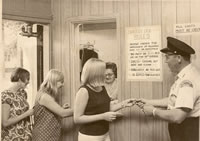 Officer Ed checks tickets at the door.
Officer Ed checks tickets at the door.
Daniel’s Den was the first teen night club in the area, and it had a lot of parents wondering what was going on inside. Jo says that she assured her parents by telling them that “It was run like St. Andrew’s." The Den had very strict rules and they were enforced by a Saginaw policeman at the door. Officer Ed Nowaczyk checked to make sure that no one who had been drinking was admitted, no girls displayed bare midriffs, and that there was no swearing inside.
Since Jo lived on W. Genessee, just a couple of blocks from Daniel’s Den, Deb’s parents would drop her there and the two would walk to the teen club. Both sets of parents considered the girls “too young” to be driving around at night with other youngsters. On nights when the girls also had to see a band playing at the Y’ A-Go-Go on Fordney, either Jo’s or Deb’s parents were always there to help out. They would pick them up and transport them to the Y for an interview, wait until they finished, and then take the girls back to the Den. It wasn’t until their senior year, when they had their driver’s licenses and Deb reached 17 that her dad finally let her borrow the family Corvair and drive themselves.
The columns that Deb and Jo wrote during that first year give us a good picture of the great variety of music available in Saginaw during 1965 and 1966. The girls saw and interviewed a ‘who’s who’ of national Pop/Rock acts with hits in the Top 40 including; The Byrds, The Kingsmen, Simon and Garfunkel, Glen Campbell, The Chartbusters, The Newbeats, The Lovin’ Spoonful, The Gentrys, Paul Revere & The Raiders, The Beau Brummels, The Yardbirds, The McCoys, Gary Lewis & The Playboys, Lou Christie, The T-Bones, The Hollies, The Young Rascals, and The Shadows Of Knight. 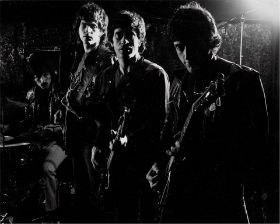 The Woolies
The Woolies
In addition, they covered many of the Michigan bands who had released regional hit singles including their beloved Bossmen, Terry Knight & The Pack, Tim Tam & The Turn-Ons, The Jayhawkers, The Underdogs, The Excels, The Five Emprees, and The Woolies.
Maybe the most interesting of the columns that Deb and Jo put together that first year involved the many high school-aged bands that had popped up across the area in the wake of The Beatles and the other British Invasion artists. The interviews and recognition that these groups got in the girls’ columns were probably the only time in their brief music careers that they were ever given publicity in a newspaper. Deb and Jo treated them all just like the headliners in the columns, and their articles serve as the only detailed record of long-forgotten bands like the all-girl Debutantes, The Bushmen, The Fugitives, The Satisfactions, The Paupers, The Motivators, The Morgues, The Rainmakers, The Mauraders, The Epics, The Chevelles, The Plagues, Lloids Of Lon-Den, The Mustangs, and The Silhouettes.
The greatest excitement within the local band scene during the time Deb and Jo were writing their column was generated by the improbable national success of ? and The Mysterians and their recording of “96 Tears”. The young Hispanic band was formed in Saginaw and recorded two original songs at Schiell’s Recording Studio in April of 1966. No recordings had more humble beginnings. The small but well-equipped studio was situated in an addition at the rear of a modest house on Raymond Street in Bay City.
“96 Tears” was initially released in the Saginaw area on the tiny Pa-Go-Go label in the spring before being picked up for national distrubution by the Cameo-Parkway label in the summer. Deb and Jo were early supporters, and first mentioned it in their column from June 25th: “All other groups can start crying “96 Tears” because this record by ? and the Mysterians is on its way to the top.” The girls included a second update on July 9th: “? and The Mysterians’ groovy disc has made No. 1 in the area, and there is an ever-increasing demand for it everywhere.”
All through the summer and early fall Deb and Jo kept Saginaw fans updated on the progress of “96 Tears” until it reached # 1 on Billboard’s Hot 100 in late October of 1966. The October 22nd issue of Showtime featured Deb and Jo’s column on the front page with the headlines: “Local Combo Captivates Nation – Mysterians’ Disc Is No. 1 In Popularity”. 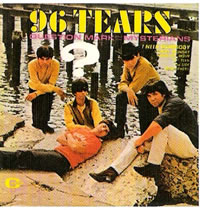 ? and Mysterians "96 Tears" LP
? and Mysterians "96 Tears" LP
The following week, October 29th, Deb and Jo’s column was again on the front page of Showtime. ? and The Mysterians had returned to Saginaw to headline a United Fund Benefit Concert at the Saginaw High School Auditorium. During their performance, the band was presented with a gold record by Neil Bogart of Cameo-Parkway Records, signifying sales of over 1,000,000 copies of “96 Tears”. The band’s management then presented plaques of appreciation several radio stations and deejays that helped with the record’s success.
Deb and Jo were also called on stage and presented plaques in recognition of their unwavering support of ? and The Mysterians and “96 Tears” in their columns. It was the high point of their writing career. Impossible as it seemed back in June, their prediction about “96 Tears” reaching the top had come true.
The only time that Deb and Jo came into conflict with Frank Patrick at Daniel’s Den was in regards to a column they wrote in early 1968 about The Lemon Pipers. The Oxford, Ohio, band had a big hit with “Green Tambourine”, a recording that relied to a great extent on psychedelic effects and echo that the band was unable to duplicate live. Deb and Jo were critical of the band in their column because they didn’t sound like their records when they played at the Den. The Saginaw News ran the column under the headline, Lemon Pipers Sour. Patrick was angry at what he considered to be bad publicity for his teen club, and he gave them a hard time about not writing anything negative. Feisty as ever, Deb and Jo stood up to Patrick and told him that it was their job to write what they truly felt. Looking back, Jo says they were “young and stupid”, but there’s nothing stupid about standing up for yourself and what you believe to be right. 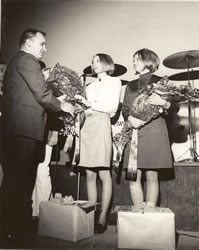 Deb & Jo Night at Daniel's Den
Deb & Jo Night at Daniel's Den
To Frank Patrick’s credit, he realized that he was wrong, and he made up for it by declaring a “Deb and Jo Night” at Daniel’s Den. The event took place shortly before their high school graduation in June of 1968, on the evening that they retired from writing their column. The girls were each presented bouquets of red roses by the Den’s assistant manager Robert Moran along with plaques of appreciation for all of the columns they had written for the past three years.
Both Deb and Jo enrolled at Delta College in the fall, but their paths started to split shortly thereafter. Deb started in journalism, but soon went into television and radio and got a job at Delta College’s Channel 19. She finished her two years at Delta and planned to continue in that field, but she met someone and got married, thereby putting an end to that dream. She and her husband moved to Colorado, had two sons, and then later divorced. Deb is currently working in inventory control for the Interstate Chemical Company in Colorado.
Deb no longer has any of the columns she wrote with Jo for the Saginaw News. When she moved to Colorado they were left at her parents’ house. A few years later, when her parents moved into a condo, the articles were disposed of. When I spoke to Deb on the phone recently, she told me that she hasn’t done any writing since attending classes at Delta, and that she didn’t tell her two sons (now law enforcement officers aged 34 and 31) about her writing adventures until they were grown. Her sons found out after someone had mentioned to them that their mother used to write for a newspaper.
Jo went into communications at Delta, but decided to leave school after one year to take a job in a bank in downtown Saginaw. She worked there for a few years before moving to Wisconsin and accepting a job at a bank there. She met her future husband in Wisconsin and they were married in 1975. They later moved to Michigan and live in Suttons Bay, located about 15 miles north of Traverse City. Jo is currently working part-time as a field interviewer for the United States Public Health Service. Her husband Dale is retired.
Jo still has copies of all the columns she and Deb wrote from 1965 to 1968, along with a collection of publicity stills from many of the bands they wrote about. She also has an interesting collection of autographs from many of the bands and singers they interviewed as well as other memorabilia from those glory days as Saginaw’s first female Rock and Roll reporters.
Somehow these great friends and writing pioneers lost track of each other in the '70s, and they would become separated for the next 30 years. They reconnected after Deb came back to Michigan a few years ago to visit her sister who lives in the northern Michigan town of Alden. Jo said “It was great seeing each other after so many years and discovering that we are still soul mates, and even as grown women we remain very much alike”. In one of our phone interviews Deb explained; “We both have a lot of faith and we think about things the same way. To come back together and see that we’re still on the same page; we realize what we have and how precious it is.” 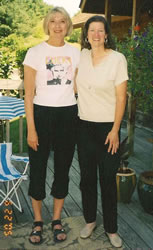 Deb and Jo in a recent photo
Deb and Jo in a recent photo
I only know any of the above facts because of both luck and persistence. I grew up in Bay City and never had the occasion to read the Saginaw News until well after the girls had left the paper. I only found out about Deb and Jo’s column because I ran into Bob Darbee at a golf course in 2009. Bob was one of the former owners of Roll-Air, Bay City’s teen music hot spot during the summers in the '60’s and early '70’s; and I asked him if I could look over any of the materials he still had from Roll-Air for my web site. All he had left was one folder with some photos, handbills, news releases, and one yellowed column written by Deb and Jo from 1966 about the Den’s battle of the bands competitions.
I immediately wanted to talk to the girls (now women) who had written the column, but their last names were not listed. Several phone calls to the Saginaw News proved fruitless. No one had any interest in researching two people who had written for the paper over 40 years ago. Several suggested that I contact Sue White, the paper’s recently retired entertainment writer. I sent White two detailed emails about my inquiry but I did not even get the courtesy of a reply.
I figured I had reached a dead end, but after I used Deb and Jo’s column to help me write a piece about Daniel’s Den, I took up the search once more. I had no luck interviewing several people at White’s Bar who had attended events at the Den. Several other people promised to ask their brothers and sisters about Deb and Jo, but no one who took my business cards ever called back.
My first real lead came at the most unlikely of places. Lynn-J and I had been members of the River City Dance Club for years, but the club had fallen on hard times the last few years as the membership slowly dwindled. As a result, the club’s final dance was going to be held on Friday, December 10, 2010. 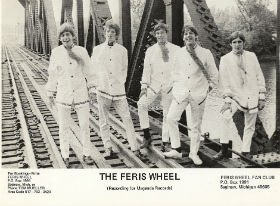 Bob Hughes (left) in The Feris Wheel
Bob Hughes (left) in The Feris Wheel
The DJ hired for the evening was Bob Hughes from WHNN-FM. I knew that Hughes used to play in two Saginaw bands in the '60s, The Paupers and the Feris Wheel, so I went over to talk to him as he was setting up. When I asked if he remembered a column in the Saginaw News written by Deb and Jo, he told me he did. I explained that I was trying to get in touch with them but I didn’t know their last names, or married names, or even if they were married. I was disappointed when Hughes told me he didn’t recall their last names, but as I turned to walk away, he suddenly said: “Wait a minute, I seem to remember that Deb’s last name was Harden”.
The first thing I did on Saturday morning was to get out the phone book and look up the name Harden. There were ten numbers listed, nine from Saginaw and one from Birch Run. I started calling each number, feeling just a little stupid asking people that I didn’t know about a girl named Deb who wrote a column in the Saginaw News 45 years ago. I hit pay dirt on my seventh call, however, when I spoke to a very nice lady named Mary Harden. When I asked about Deb and the column, she said; “I don’t remember anything about a column, but that sounds like something that Deb might do”.
Mary was Deb’s aunt, and she told me that Deb’s married name was Sheldon and that she lived in West Pueblo, Colorado. Mary didn’t have Deb’s phone number, but she did have the number for her sister who lived in Alden. She said she would call her for the number and call me right back. As a result, I got in touch with Deb that day. Deb then gave me Jo (Hintze) Monday's number and I contacted her as well. 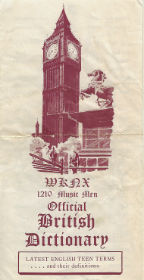 Jo's WKNX British Dictionary
Jo's WKNX British Dictionary
Since those first phone calls, I’ve been able to locate all of Deb and Jo’s columns on microfilm at the Hoyt Library in downtown Saginaw. They are a treasure of information about the teen music scene in Saginaw from 1965 to 1968, especially at Daniel’s Den, the nicest and most highly regarded teenage night club in mid-Michigan.
I’ve taught two courses on Women in Rock during the last couple of years through the Osher Lifelong Learning Institute at Saginaw Valley State University, and that has provided an opportunity to research what Deb and Jo accomplished in a historical setting. Prior to 1964, there were virtually no women writers in the field of Rock and Roll. The very first female appears to be Gloria Stavers, who became the editor of 16 Magazine in 1964 at the age of 38, and is credited with inventing Rock and Pop-culture journalism as we know it today.
Deb and Jo started their column just one year later as teenagers. Tiger Beat, a rival to 16 Magazine,began publication in the fall of 1965 and its first issue had Sonny & Cher on the cover. Deb & Jo had been publishing their column in the Saginaw News for two months by that time, and had already interviewed Sonny and Cher. To further emphasize their role as trailblazers, Rolling Stone magazine, the most famous Rock music publication in the United States, did not come out until 1967, and Michigan’s highly respected Creem magazine did not appear until 1969.
Even in these well-known publications, female writers were in a very distinct minority well into the 1970s. In speaking with Deb and Jo, I discovered that they had no idea that they were female pioneers in the field of Rock writing, and that they were mos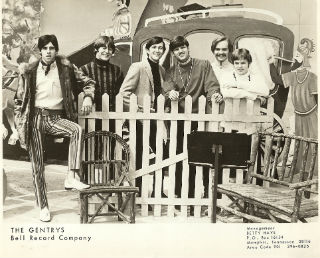 The Gentrys from Jo's photo collectiont likely the first young ladies to ever write about Rock and Roll in the state of Michigan.
The Gentrys from Jo's photo collectiont likely the first young ladies to ever write about Rock and Roll in the state of Michigan.
The recognition doesn’t seem to be that important to either of them. Deb explained it this way in one of our phone conversations; “I wouldn’t trade my life for anything. I’ve done all the things I was supposed to, and I’ve taken care of who I’ve supposed to, and so I don’t worry about it.” As for her partnership with Jo, she said, “We realize now how lucky we were to be different. We understand how unique our high school years were, and how they played a huge role in our lives as we went on from there.”
I’m hopeful now that the two friends have reconnected, they might be inspired to work on one last writing project. The only goal that the dynamic young duo did not accomplish was the publication of their book. It can still happen, however, and what they have to offer now is much greater than the pages they sent Simon and Schuster back in 1965.
If Deb and Jo have retained their knack for being able to “think outside the box” and still have some of the passion they exhibited when writing together in their youth, these women are now in a position to impart some very valuable lessons by simply sharing what they accomplished as trail-blazing female journalists. I have a feeling that their story could better help us to realize that the gender roles that society imposes on us are often neither wise nor fair, that it’s okay to be a little different; and most importantly, to understand that there are no limits to what we can achieve if we have belief in ourselves.
